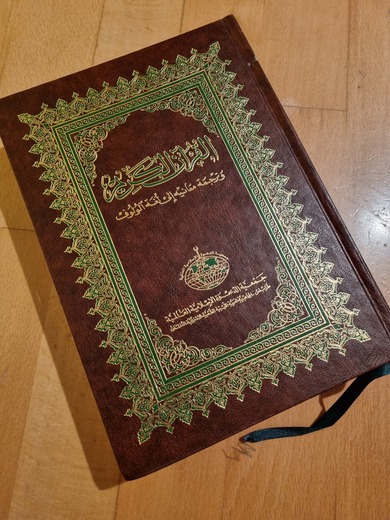In 2003, the Libya-based World Islamic Call Society (WICS) published a new translation of the Qur’an into Wolof, authored by Assane Sylla (also known as Asan Silla), a scholar from Senegal. This was quite a significant cultural milestone for the Wolof people, a West African ethnic group who live in Senegal, Gambia and Mauritania. Senegal, as with other predominantly Muslim countries in West Africa, had become a place of interest for countries such as Saudi Arabia and Libya, which were at the time seeking to increase their influence. The World Islamic Call Society accordingly happened to be the first to publish a Wolof translation, but it is perhaps surprising that no Wolof translation was published until 2003, as this is quite late compared to modern Hausa and Yoruba translations, which were available from the late 1970s.
The translation was written in Latin script in accordance with a set of decrees issued by the Senegalese government between 1971 and 1985 (rather than the Arabic based script, Wolofal, which is commonly used in Islamic schools). This work, alongside an Ahmadiyya translation, constitutes the first modern complete interpretation of the Qur’an into Wolof. With the exception of one earlier, incomplete work (a translation of selected suras by Pathe Diagne published in Paris by L’Harmattan in 1997), almost all previously published tafsīrs and translations/interpretations were based on the Arabic script or, in the case of some mid-twentieth century sources, were transmitted orally via the traditional Islamic learning system, and sometimes through audio recordings.

The translator of Alxuraan, Assane Sylla (1928–2012), is regarded as an outstanding member of the Wolof intellegensia: born in Dakar, at the time French West Africa, he went on to pursue a higher education in Psychology and Philosophy in Grenoble and Paris. In 1976, Sylla completed a PhD at the Sorbonne on the Moral Philosophy of the Wolof people. Later published as a monograph under the title La philosophie morale des Wolofs, this work remains one of the most important sources for the understanding of colonial and post-colonial Wolof intellectual movements. Sylla was a member of the Federation of Students of Black Africa in France (FEANF) in the 1950s, an organization that promoted Pan-Africanism, and after Senegalese independence in 1960 he played a significant role in the development of the Wolof Latin alphabet and the promotion of the local literary tradition, most notably through his speeches and translations. At the time he was working on his translation of the Qur’an, during the 1980s and 1990s, he was affiliated with IFAN (the Institut Foundamental d’Afrique Noire). A former French colonial institute for the study of West African culture established in 1936, after Senegal’s independence this think tank became a leading academic center for the promotion of national culture.
Alxuraan overall conforms to the standard WICS publishing format for Qur’an translations. It contains the Arabic text in page-by-page format alongside the target text, which is provided in the Ḥafṣ variant reading, despite the fact that the Warsh reading remains predominant in Senegal according to a 2016 study by The African Holy Quran House. The text contains no footnotes or commentary, although the actual translation includes some insertions in brackets, mostly explaining the use of pronouns and clarifying the speaker in various instances (i.e., whether it is God, Muhammad, or another speaker). The translation is quite literal in its style, although (unusually for a Muslim translation) the names of the suras are not included in their original Arabic, but in translation only. Thus, the title of Q 1 is ‘Benneelu Saar. Ubbiku Ji’ (‘First Surah. The Opening One’), while Q 2 is ‘Ñaareelu Saar. Nag Wa’ (‘Second Surah. The Cow’); the same format is repeated in the table of contents. The absence of any Arabic loan words (which are sometimes used in Wolof Islamic religious practice) indicates that the translation is an attempt to translate almost everything for the reader, and is aimed at a general readership rather than a specifically Muslim one, and that the author viewed it as not just a religious project but a contribution to national culture.

A small appendix to the translation (‘Xamle’) lists the sources used by Assane Sylla, amongst which are audio recordings of tafsīr lessons in Wolof from the biggest Islamic authorities in Dakar, such as Maxtaar Jeh, Ibraahima Nas and Saxiir Gay. The only classical tafsīr source mentioned is Ibn Kathīr’s work (and this may be a sign of some Salafi or at least anti-Sufi reformism in the West African context). Sylla also consulted works in French, especially by Hamza Boubakeur, Regis Blachere and, finally, Muhammad Hamidullah. It is worth mentioning that that these interpretations were the most popular in the Francophone world in the late 1980s.
Overall, it is not easy to evaluate the level of distribution of Assane Sylla’s work (it is not known how many copies were printed and whether any new editions came out after 2003), but the work remains an important step towards the development of Wolof literary tradition (in the Latin alphabet) in post-colonial times. The choice to publish this translation also generally fits in to the general pattern of late WICS activities which aimed not only to promote Islam in Africa, but also to raise the level of national consciousness in the languages and countries in which it was published.
Mykhaylo Yakubovych
